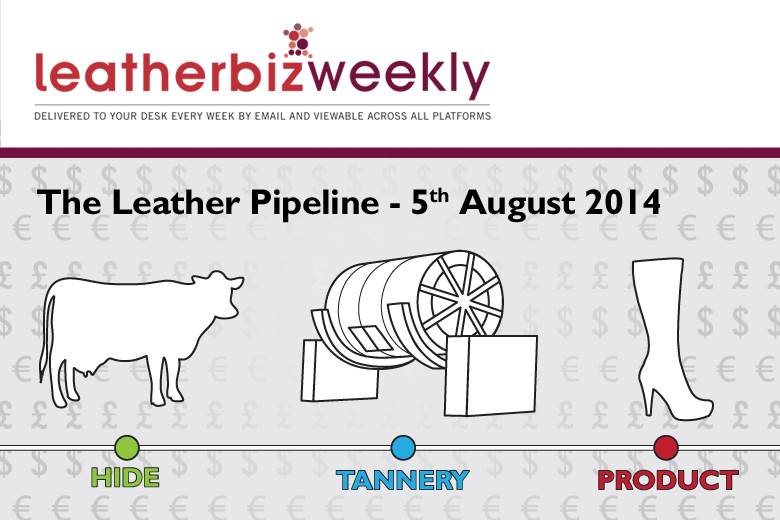Leather Pipeline: Hide buyers turn to Europe as dollar makes US less attractive

The markets are developing in a classic summer pattern. The suppliers are trying to prevent the prices declining because of inactivity while many tanners are not interested in a correction because they will soon have to meet their customers for leather price negotiations for the coming season. Greater market volatility is not desired by anyone. So far it is working pretty well for everyone.
However, the fundamental questions remain unanswered: What can we expect from the next leather season? What are the trends, what is the fashion, what about the pricing in retail? Will there be an impact from the political tensions? Are financial resources sufficient? And many more.
The irritating factor is that, except in public trade reports, no one reports any buoyant business and firm prices. The numbers do not fit. The price tags are raised, but the numbers of sales decline. This is strange, if looking at the offer lists and a week later at the official sales numbers from the US.
However, several suppliers from other parts of the world like it, because the combination of higher asking prices in the US and a stronger dollar offers far better selling options than several weeks ago and they are pleased to see many customers in the past weeks buying alternatives, which look far more attractive.
Those who are satisfied with their order books don’t complain about business, but are admitting their shipments are not at the same speed as their sales. Most of the regular and reputable suppliers speak about an average of two to four weeks’ delay between the contracted shipping period and the arrival of letters of credit, which allow them to move product. We are not hearing about any cancellation or failures, but the situation is not reflecting a solid market.
Some of the larger importers and wholesalers of raw or wet blue in China are also very prudent about what they expect. The majority of those we spoke to were complaining about the consequences of the closures in Hebei [tanneries that were deemed to fall below environmental standards were closed by the Chinese government]. Many of their clients in the region couldn’t take their deliveries, many had cashflow problems and many were worrying about their stocks and valuation. The ones we spoke to said the situation is beginning to ease and most of the stocks have been cleared, but with losses, and they are quite cautious. They added that they had delayed many shipments until the fundamental problems are resolved.
The only straightforward businesses are the group of large, industrial players and the automotive tanning industry. Large order books in the auto industry and high sales in most of the established markets make it pretty clear where most of the raw material, which should have been hanging in the market since April, has been absorbed.
However, we are witnessing a widening gap between the standard articles and the non-standard ones. Tanners with a good network, good raw material knowledge and flexibility are finding a number of attractive raw materials offered at prices which are far lower per square foot than the standard items quoted every day as the market reference. In our opinion, there is good money to be made if one knows how to select. The month of August will certainly not give us any answers, but anyone who is willing or in the position to act accordingly might use the holiday break to check what this could mean if the conditions allow.
At this stage we believe that we are again at a junction in the leather pipeline after the extremely strong performance of recent years, and the industry is looking for a new and safe market order. The present price spreads and conditions cannot be justified if the normal calculations and standards are used. Either we arrive at new definitions of value or a restructuring of prices is required.
The split market is the same summer doldrums as the hide market; the fundamental problems are the same. Product flow is not intact and there are many problems to be resolved. The Shanghai leather show [ACLE, September 3 to 5, 2014] might give us some direction, or when production is back on track in September we might see light at the end of the tunnel.
There have been no real changes in the skin market, either. The summer lull, Russia and the Ukraine, uncertainty of fashion and shortage of money are the main factors. Strong businesses have realised many prices are low and unlikely to fall much further. A little money buys a lot of skins these days and some are picking and choosing, knowing that the possession of cheap raw material has never been wrong - although some always think it can go lower. However, like with hides, the good sellers are still reasonably comfortable while others struggle to keep their product moving. We can’t see any changes in August.
For the next two weeks we think the market will remain as it is. Suppliers will not change their attitudes and with the ACLE only four weeks away there will be no one willing to change prices, other than to test if more can be obtained.
Various big players will also pave the way for their trips to Asia and customer meetings and this is certainly not done with pessimism. Quite the reverse: it is easy to see that they continue to play the supply card and tease buyers with the risk of not enough material. As long as tanners are not in the position or not willing to react and consider alternatives, the strategy might work. You can only buy what the owner is willing to sell and only at the price he accepts. The more you narrow your perspective, the more you have to pay.
So, for the coming weeks, we think the market will be in balance and stay where it is.











